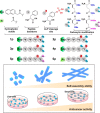Self-Assembling Ability Determines the Activity of Enzyme-Instructed Self-Assembly for Inhibiting Cancer Cells
- PMID: 28990765
- PMCID: PMC5669277
- DOI: 10.1021/jacs.7b07147
Self-Assembling Ability Determines the Activity of Enzyme-Instructed Self-Assembly for Inhibiting Cancer Cells
Abstract
Enzyme-instructed self-assembly (EISA) represents a dynamic continuum of supramolecular nanostructures that selectively inhibits cancer cells via simultaneously targeting multiple hallmark capabilities of cancer, but how to design the small molecules for EISA from the vast molecular space remains an unanswered question. Here we show that the self-assembling ability of small molecules controls the anticancer activity of EISA. Examining the EISA precursor analogues consisting of an N-capped d-tetrapeptide, a phosphotyrosine residue, and a diester or a diamide group, we find that, regardless of the stereochemistry and the regiochemistry of their tetrapeptidic backbones, the anticancer activities of these precursors largely match their self-assembling abilities. Additional mechanistic studies confirm that the assemblies of the small peptide derivatives result in cell death, accompanying significant rearrangement of cytoskeletal proteins and plasma membranes. These results imply that the diester or diamide derivatives of the d-tetrapeptides self-assemble pericellularly, as well as intracellularly, to result in cell death. As the first case to correlate thermodynamic properties (e.g., self-assembling ability) of small molecules with the efficacy of a molecule process against cancer cells, this work provides an important insight for developing a molecular dynamic continuum for potential cancer therapy, as well as understanding the cytotoxicity of pathogenic assemblies.
Conflict of interest statement
The authors declare no competing financial interest.
Figures









Similar articles
-
Kinetic Analysis of Nanostructures Formed by Enzyme-Instructed Intracellular Assemblies against Cancer Cells.ACS Nano. 2018 Apr 24;12(4):3804-3815. doi: 10.1021/acsnano.8b01016. Epub 2018 Mar 21. ACS Nano. 2018. PMID: 29537820 Free PMC article.
-
Enzyme-Instructed Self-Assembly of Small D-Peptides as a Multiple-Step Process for Selectively Killing Cancer Cells.J Am Chem Soc. 2016 Mar 23;138(11):3813-23. doi: 10.1021/jacs.5b13541. Epub 2016 Mar 11. J Am Chem Soc. 2016. PMID: 26966844 Free PMC article.
-
Enzyme-Instructed Supramolecular Self-Assembly with Anticancer Activity.Adv Mater. 2019 Nov;31(45):e1804814. doi: 10.1002/adma.201804814. Epub 2018 Nov 16. Adv Mater. 2019. PMID: 30444545 Review.
-
Selectively Inducing Cancer Cell Death by Intracellular Enzyme-Instructed Self-Assembly (EISA) of Dipeptide Derivatives.Adv Healthc Mater. 2017 Aug;6(15):10.1002/adhm.201601400. doi: 10.1002/adhm.201601400. Epub 2017 Feb 24. Adv Healthc Mater. 2017. PMID: 28233466 Free PMC article.
-
Enzyme-Instructed Self-Assembly for Cancer Therapy and Imaging.Bioconjug Chem. 2020 Mar 18;31(3):492-500. doi: 10.1021/acs.bioconjchem.0c00025. Epub 2020 Feb 7. Bioconjug Chem. 2020. PMID: 31995365 Free PMC article. Review.
Cited by
-
Enzymatic Noncovalent Synthesis.Chem Rev. 2020 Sep 23;120(18):9994-10078. doi: 10.1021/acs.chemrev.0c00306. Epub 2020 Aug 19. Chem Rev. 2020. PMID: 32812754 Free PMC article. Review.
-
Enzyme-Instructed Intracellular Peptide Assemblies.Acc Chem Res. 2023 Nov 7;56(21):3076-3088. doi: 10.1021/acs.accounts.3c00542. Epub 2023 Oct 26. Acc Chem Res. 2023. PMID: 37883182 Free PMC article.
-
Cell-Free Nonequilibrium Assembly for Hierarchical Protein/Peptide Nanopillars.J Am Chem Soc. 2024 Sep 25;146(38):26102-26112. doi: 10.1021/jacs.4c06775. Epub 2024 Sep 10. J Am Chem Soc. 2024. PMID: 39255453
-
Assemblies of d-Peptides for Targeting Cell Nucleolus.Bioconjug Chem. 2019 Oct 16;30(10):2528-2532. doi: 10.1021/acs.bioconjchem.9b00524. Epub 2019 Sep 27. Bioconjug Chem. 2019. PMID: 31550136 Free PMC article.
-
Peptides Targeting HER2-Positive Breast Cancer Cells and Applications in Tumor Imaging and Delivery of Chemotherapeutics.Nanomaterials (Basel). 2023 Sep 1;13(17):2476. doi: 10.3390/nano13172476. Nanomaterials (Basel). 2023. PMID: 37686984 Free PMC article. Review.
References
Publication types
MeSH terms
Substances
Grants and funding
LinkOut - more resources
Full Text Sources
Other Literature Sources
Research Materials

